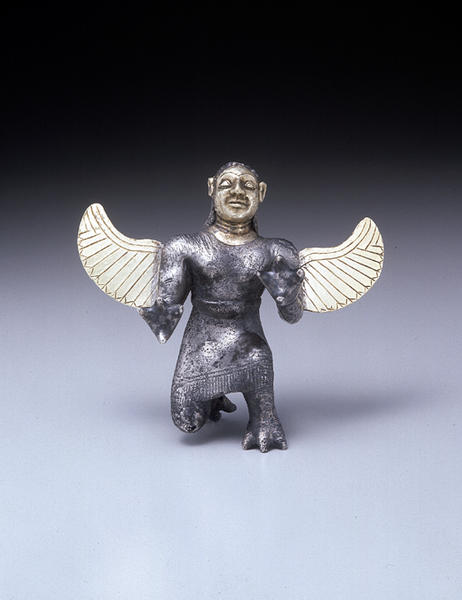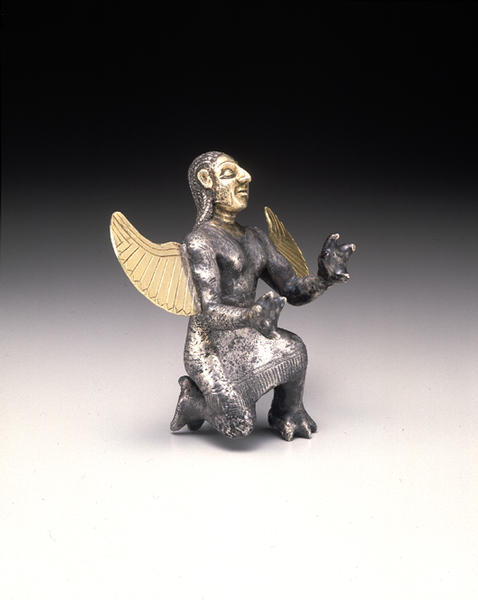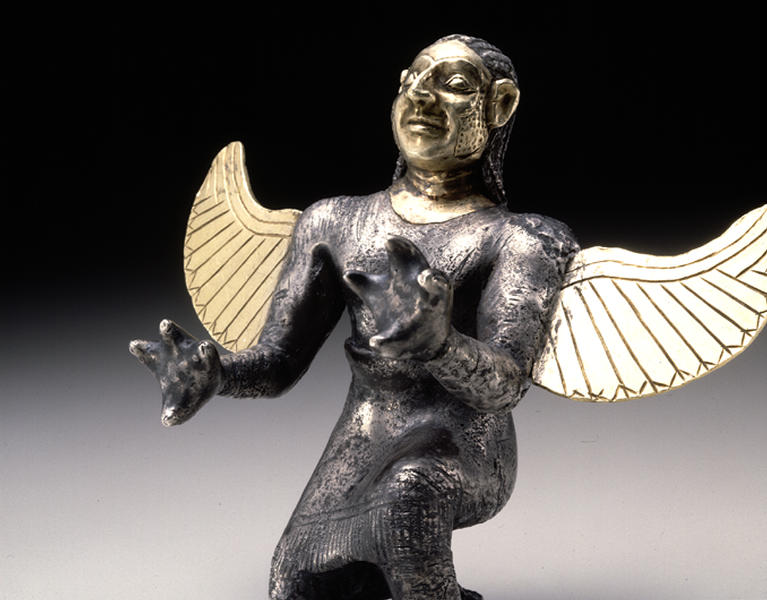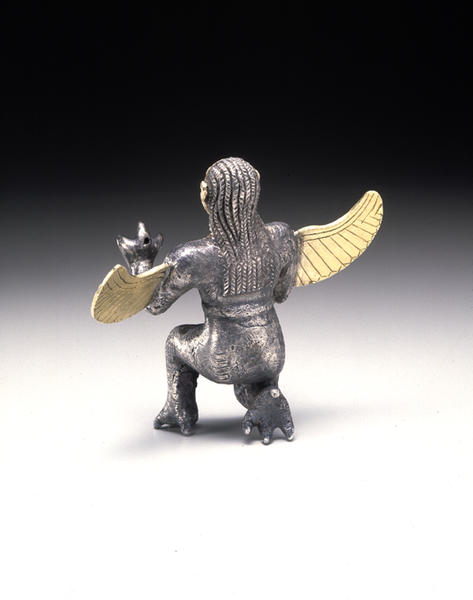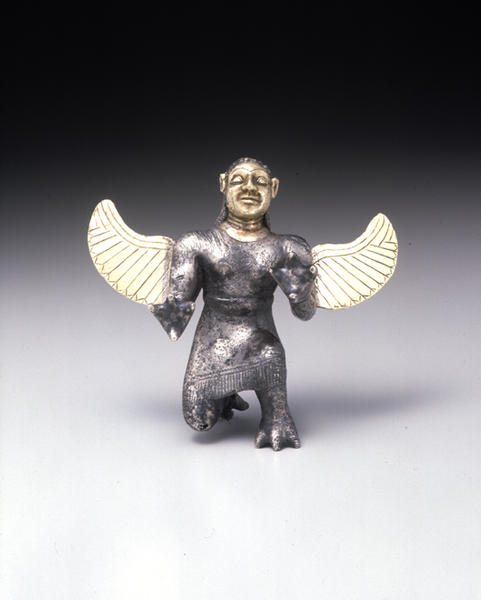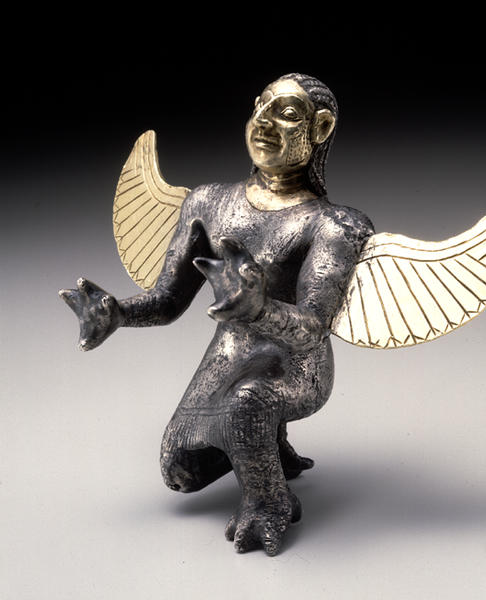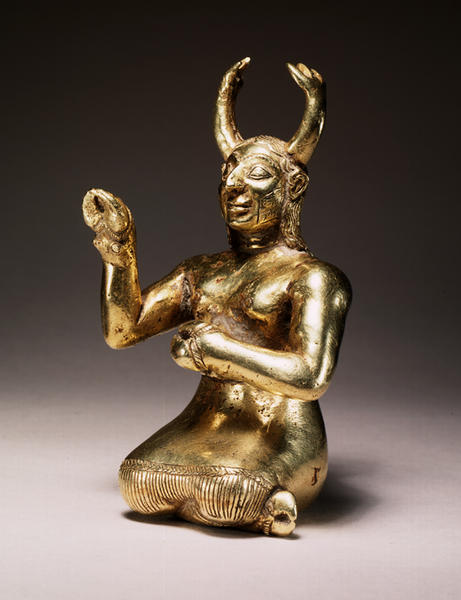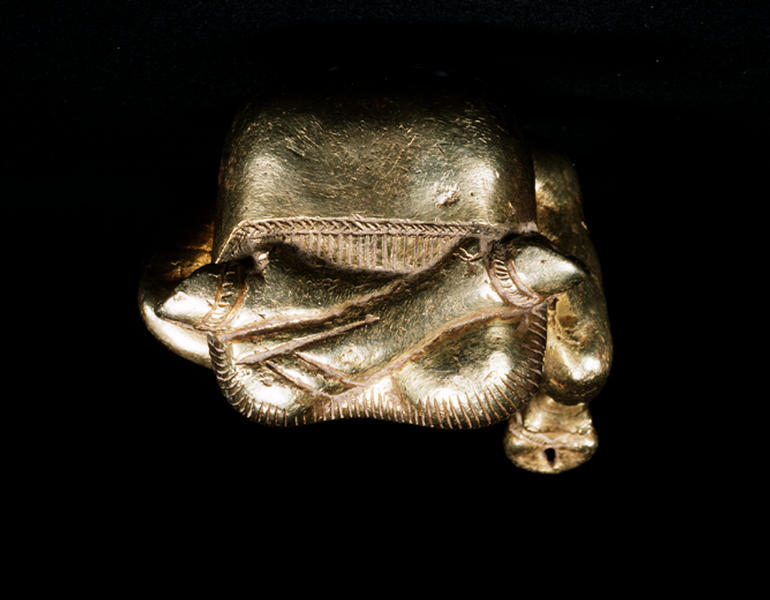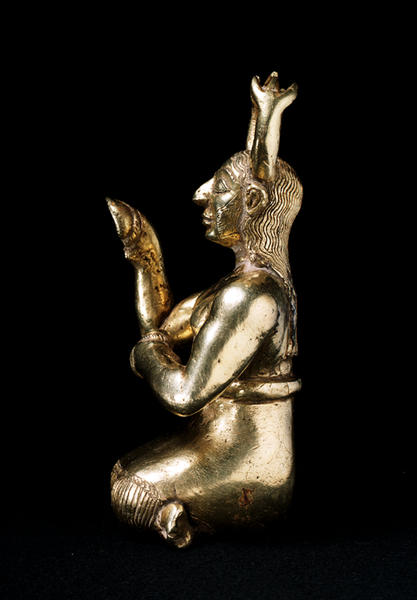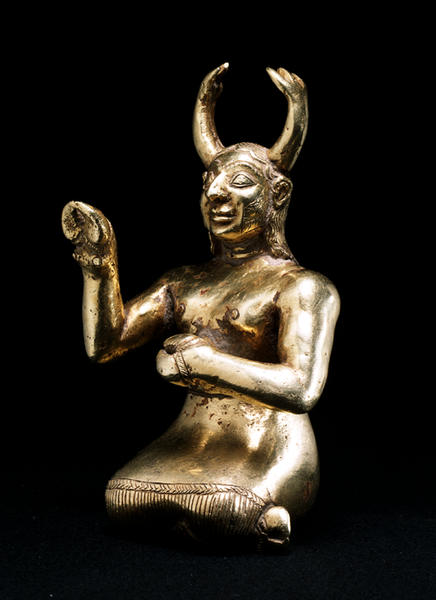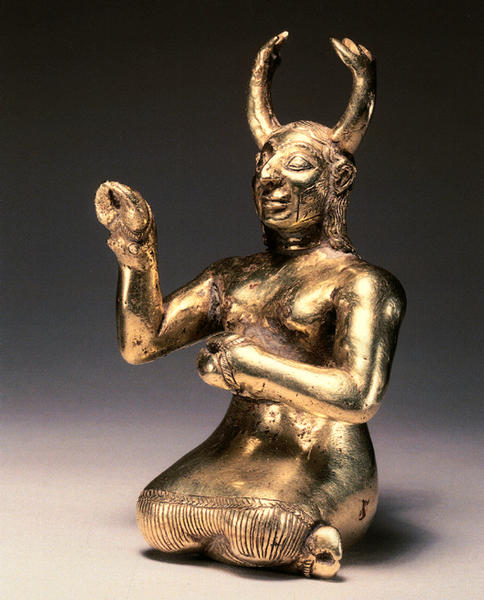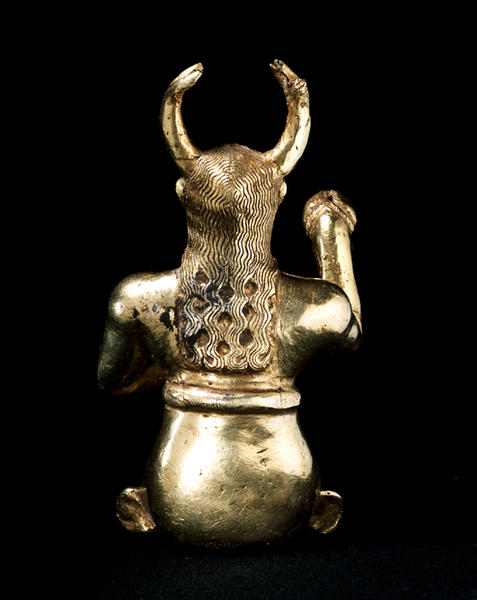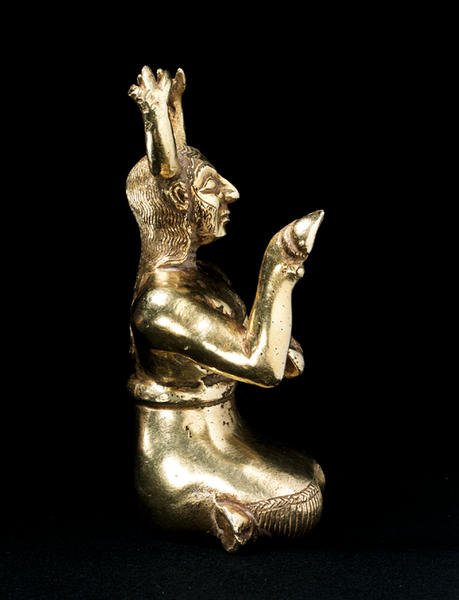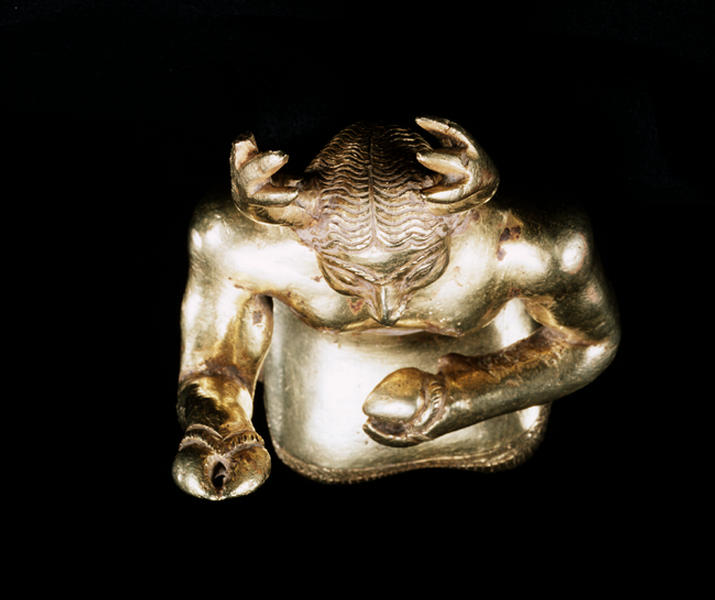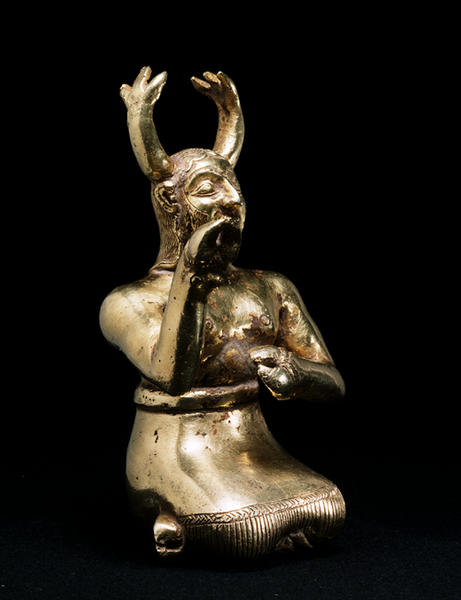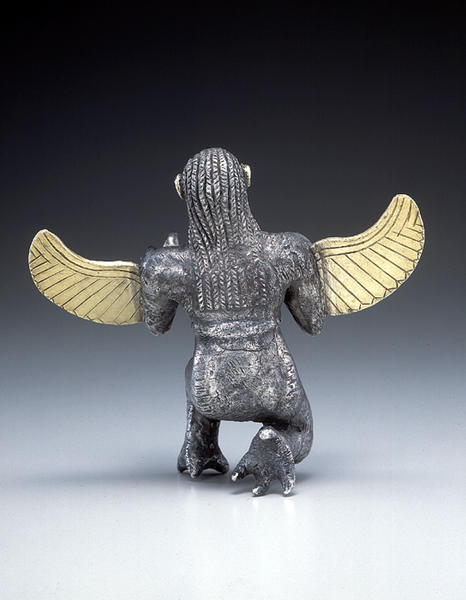有翼神霊坐像
- 南または東イランか
- 紀元前3千年紀後期-紀元前2千年紀初期
- 銀、エレクトラム
- H-12
解説(開館1周年記念展)
銀の小像は左膝を立てて跪き,顔をやや上空に向けて両腕を前に差し出す。がっしりとした肩の左右,両上腕側面から剣状の羽根が刻まれた大きなエレクトラムの翼が生え,四肢の末端は鳥形の4本爪になっている。頭髪は幾筋かの杉綾文風に刻んだ房を背中に垂らし,額から耳を含んだ顔面そして胸元の丸い襟刳りまでエレクトラムの薄板が被せられている。
エレクトラムの小像は,脚を深く組み両脚先を左右に見せて正座する。四肢の先端は偶蹄類の蹄になっており,右腕をあげ前方に蹄裏を向け,左腕を中程まで上げて蹄裏を腹部に向けている。頭部に先端で三叉に分かれた2本の牛角を頂き,ややウエーブのかかった頭髪を中央で分けて背中に垂らしている。この角は知られる限り類例を見ないが,あるいは三重の角もしくは角先の房飾りを意図したものかも知れない。
どちらの小像も本体は12センチ程で,首に2本の皺を引き,胸に乳頭を刻み,上半身裸形で腰を太い帯でしめたキルト状の衣服を着け,その裾端には房飾りが施されている。2像に見られる,眉間でつながって二つの弧を描く眉,鼻筋の通った高い鼻,上側がやや盛り上がった紡錘形の目はメソポタミア紀元前3千年紀後期の人物像の顔面に見られる特徴である。エレクトラム像には,頭髪の房の間隙に紡錘形の穴があいているが,これも同時期のメソポタミアの奉納人物像の髭表現に見られる。このメソポタミア風の表現をもった人物像は南イランにも類例があり,ベルリン国立古代博物館蔵のエラム由来と考えられる紀元前3千年紀の銅製小像に見ることができる。*1 銀像の頭髪の表現は東イランの特徴であり,また上半身裸形の服制自体は古代西アジアに広く見られるが,太い帯とキルトを着けて跪座もしくは正座する体勢は特に東南イランの円筒印章や石製の器に見ることができる。
東南イランのものと考えられているローゼン・コレクションの円筒印章〈挿図1〉には,太い帯をし,裾に房飾りのついたキルト状の衣装をつけて跪き,人物を内包する放射形を囲んで両腕を挙げている2人の男性の図像が見られる。彼らは頭部に獣の飾りを付けているが,超自然的な力を帯びた何らかの英雄か神官に相当すると想像されている。*2 跪く鳥形をした人物の図像は西中央アジアのスタンプ印章に見られるが,*3 この牛と鳥の組み合わせは図版2の作品と同様の西中央アジアに近い地域性を示しているとも考えられる。この2体の小像もこの動物の扮装をし,猛禽や猛牛の神的な力を帯びた英雄もしくは神官,あるいは神霊の姿を表したものだったのかもしれない。
1 Museum fur Vor-und Fruhgeschichte Berlin Nr.XIc4840
2 E. Porada/Discussion of a cylinder seal, probably from southeast Iran/Iranica Antiqua XXIII, 1988
3 Joan Aruz/Images of the supernatural world: Bactria-Margiana seals and relations with the Near East and the Indus/Ancient Civilizations from Scythia to Siberia Vol.5 No.1 March 1998
Catalogue Entry
The small silver figure squats with his left knee up, directs his face slightly upward and extends his both arms forward. A pair of large electrum wings, with engraved sword-shaped feathers, come out from each side of his upper arms. Each limb has four talons at its end. The figure's hair is shown in tufts by a herringbone-like pattern over its back, and his face, including the forehead and ears as well as the base of the neck, are covered by thin electrum sheet.
The small electrum figure sits straight, with firmly folded hind limbs with both legs shown to the right and left. Each limb has a hoof of the ungulate type at its end. The figure's right arm is held up with the bottom of the hoof directed forward while its left arm is held with the bottom of the hoof directed toward the abdomen. The head has two three-forked ox-like horns, and slightly wavy hair is parted in the middle and hangs over the back. No similar example of this horn type is known as yet; it is possible that a threefold horn or horn tassel may have been intended.
Each small figure is about 12cm high up to the top of the head. Each has two wrinkles on its neck, and nipples engraved on the breasts, the upper half of the body being naked. Each figure wears kilt-like clothing with a fringe at the skirt edge held by a large girdle. Eyebrows shown by two arcs joined at the middle of the forehead, the prominent and shapely nose and the pointed-oval eyes slightly enlarged at the upper side are special features found in the faces of statues from Mesopotamian art in the latter half of the 3rd millennium B.C. The electrum figure has pointed-oval holes in the space between hair tufts, and these are also similar to the representation of mustaches in dedicated statues in Mesopotamian art of the same period. There are examples of the similar statues representing the Mesopotamian style in southern Iran; a small copper figure of the 3rd millennium B.C. which is considered to derive from Elam, presently owned by the Museum of Antiquities in Berlin.*1 Representation of the hair in the silver figure is characteristic of eastern Iranian art, half-naked figures are commonly seen in ancient West Asian art, and the squatting or straight posture in figures wearing large girdles and kilts is found particularly in cylinder seals and stone vessels of southeastern Iran.
A cylinder seal in the Rosen collection (fig. 1), considered to have derived from Southeastern Iran, depicts two men flanking a radial design enclosing another figure. The two men wear large girdles and kilt-like clothes with a fringe at the skirt-end, and are depicted holding both arms up. They are wearing animal-shaped headdresses and are thought to represent heroic or divine males with supernatural power.*2 Figures similar to the bird-shaped figure in the squatting posture are seen in seals from Western Central Asia.*3 The combination of bull and bird is also considered similar to characteristcs of works from Western Central Asia as seen in the Miho Museum goblet (cat. no. 2 in this catalogue). These two small figures might have represented heroic or divine males dressed up as vultures or bulls with supernatural power, or may have represented deities.
